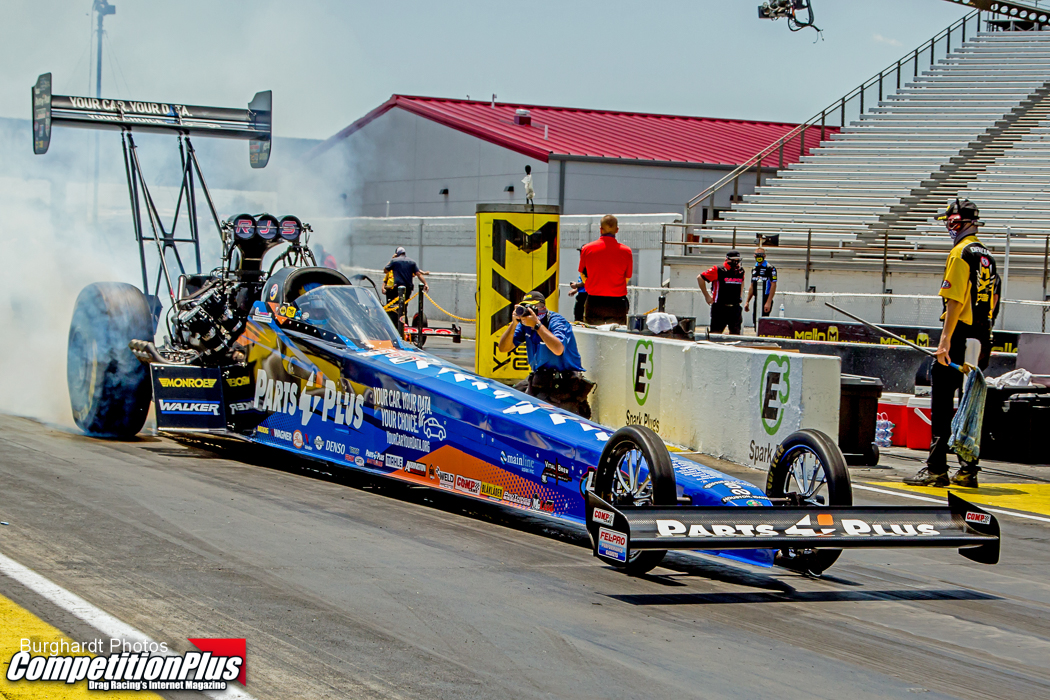NITRO PRICING HAS SMALLER NHRA TEAMS THROWING THEIR HANDS UP

While pump gas at local stations seems to be more affordable these days, the same can’t be said of nitromethane.
The price of what fuels the planet’s quickest and fastest vehicles has skyrocketed to about $1,680 for a 42-gallon drum.
And team owners Terry McMillen and Doug Stringer say that’s “insane” and “bizarre” and are calling for everyone to work together to fix what most definitely is a problem.
McMillen and Stringer, who fields the Top Fuel dragster driven by Clay Millican, agree that the exorbitant costs are debilitating for multicar teams as well as single-car teams.
“I think it's insane, you know what I mean?” McMillen said. “I understand that they got to carry so much fuel back so that it's available at all times. But the cost of nitro is not that much. We're just being penalized for trying to keep the sport alive. And it's just not fair. There's so many independent teams out here and even the big teams are feeling the squeeze on this.”
He said the supplier “stepped up and is going to make sure we get a couple hundred bucks back after both Indys. But the fact of the matter is it's ludicrous to be that high. It's time for a change. Somebody needs to step up and fix it, because it's just wrong and we're going to lose cars and continually lose cars because people can't afford the nitro on the runway.”
McMillen’s solution is that “we need to get some money back into sport so that we have more cars. But then at the same time, it takes money to run the operation, energy and all that, as well. But we just got to work collectively to try to figure this out, because the nitro teams can't carry the load for the cost of nitro. And I think that we just got to find a way of getting more sponsors back in here. The only way we're going to do that is getting more cars out here.”
Stringer said he hoped to see the NHRA move more into the team owners’ corner when it comes to nitro procurement.
“Well, the cooperation that we're getting from NHRA is less than a satisfactory, period,” he said.
“We come out here, we bring sponsors out here, we bring fans out here, we bring people out here, and the fact that I do believe, and this is me personally, I believe that the product can be purchased at a much more reduced price from other vendors. The fact that we're held... we can't bring other nitro in here, we have to do what they tell us we have to do,” Stringer said. “Sunoco's a great company, been a great supporter of the sport for a long time, but there is a deal in place with Sunoco and NHRA, that I believe NHRA receives some financial support from Sunoco as an official fuel of NHRA. However, I don't see that translated in the pricing of what we're paying for nitro.”
For example, he said Friday’s test session caused a domino effect of concern.
“We came out here to test and I got one of those little drums of nitro over there, and I got a bill for it. And there was some miscommunications on all parts, as far as when we can make our last run yesterday. I needed to test really bad. This team is, I don't want to use [the term] ‘in a survival mode,’ but we turned pennies into nickels, nickels into dimes, dimes into quarters, and I don't think they make half dollars anymore, maybe they do. But anyway, it all comes down to putting the competitor and the fans first,” Stringer said.” We're an entertainment industry. We have to be able to afford to come out here to entertain the fans. And the fans are the ones that cause us to get sponsors. Without fans and the correlation between the two and the marketing and the media that go behind it, we can't put those fans where they need to be with their sponsors if we're not here.”
A letter from Josh Peterson, NHRA vice-president of racing administration, mentioned a rebate for fuel purchased. Evidently, it was more confusing than encouraging.
“I read a letter that stated that NHRA would rebate a portion of the nitro costs, but I don't know where that money's coming from,” Stringer said. “I don't know when we're getting it or how we're getting it. That wasn't explained to us so that's somewhat of a mystery. I mean, will we get it? Yes. If Josh Peterson said it, I take him for his word. I mean, one thing I will say about those guys [NHRA officials] is they won't lie to us. But sometimes they won't necessarily answer the question, either. But they won't lie to us. So if they say they're going to give us a rebate, it'll be somewhere.”
That triggers the rationality that if the price of the fuel additive isn’t so high, the NHRA wouldn’t have to offer a rebate.
Stringer said, “If you think about it, it is somewhat bizarre, period. Why wouldn't you just go to the vendor and negotiate better pricing if the nitro itself is less expensive versus creating a rebate somewhere, whether it be from point fund money or from winnings?
“We took a significant cut in our purse money, which is what a lot of us survive on. Now, mind you, they came back with another significant cut on charges, like parking our transporters here, hospitality fees, so it was kind of a give and take,” he said. “They're in a really bad position. My dad told me not to bring a problem, but I don't have an answer. I don't have an answer other than making better deals.”






































